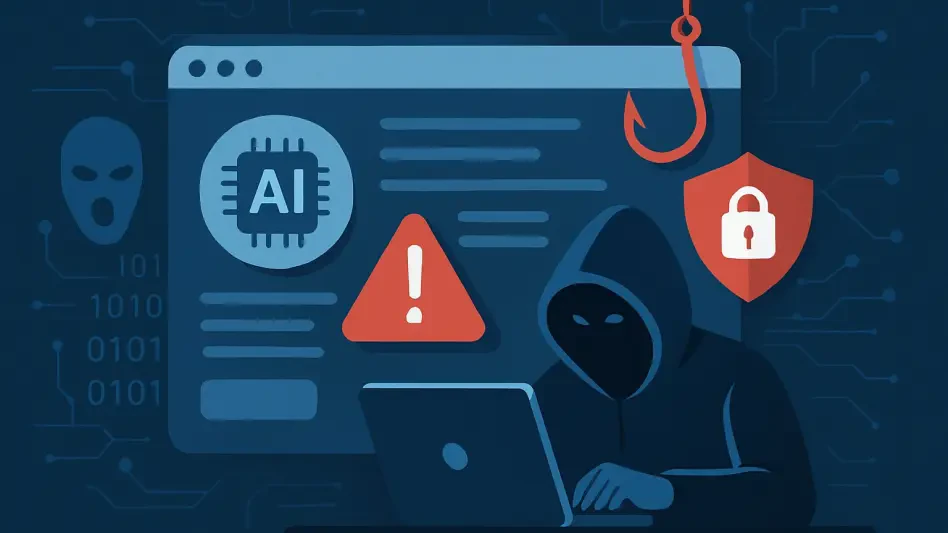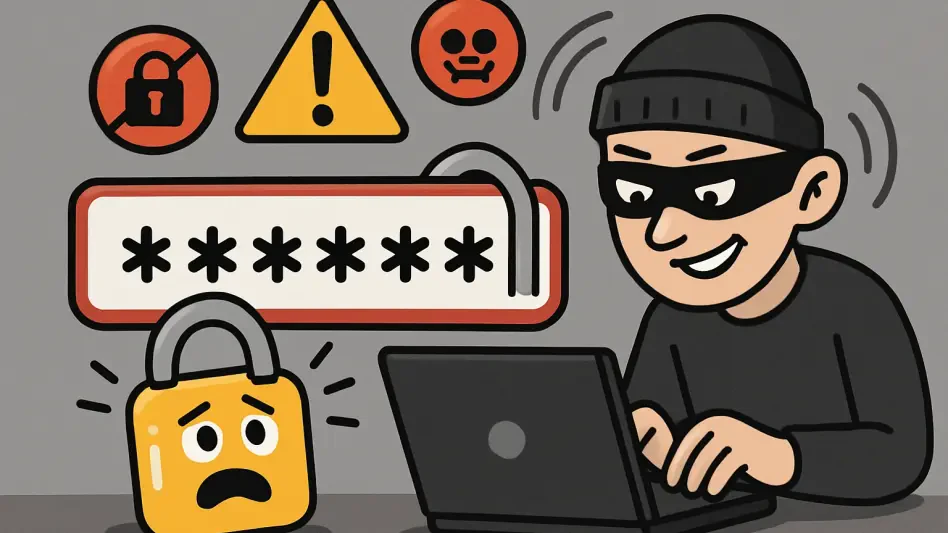Imagine launching a fully functional website in mere minutes, with no coding skills required, simply by typing a few descriptive prompts, and having it hosted for free. This is the promise of Lovable, an AI-powered website builder that has democratized web creation for countless users under the lovable.app domain. However, this accessibility has come at a steep cost, as cybercriminals have exploited the platform to orchestrate phishing schemes, financial scams, and malware distribution on an alarming scale. This review delves into the innovative features of Lovable, uncovers its vulnerabilities, and examines the broader implications for AI-driven tools in a landscape increasingly fraught with digital threats.
Unpacking Lovable’s Core Capabilities
Lovable stands out as a game-changer for individuals and small businesses seeking to establish an online presence without technical expertise. By leveraging AI, the platform transforms simple text inputs into polished websites, complete with free hosting and customizable designs. Users can publish their sites swiftly, with an optional “Edit with Lovable” badge that can be removed through paid plans, catering to those desiring a more professional appearance.
The appeal lies in its simplicity and efficiency, breaking down barriers that once made web development a daunting task. This user-friendly approach has attracted a wide audience, from entrepreneurs to hobbyists, who value the ability to iterate designs rapidly. Yet, this very ease of access has also drawn the attention of malicious actors looking to exploit the platform’s capabilities for illicit purposes.
Beyond basic creation, Lovable offers tools for customization that rival more complex builders, allowing for tailored aesthetics and functionality without the need for deep technical know-how. While this empowers legitimate users, it simultaneously provides a low-friction environment for bad actors to craft deceptive sites that mimic trusted brands, highlighting a critical oversight in initial design priorities.
Vulnerabilities Exposed: A Haven for Cybercrime
One of the most significant flaws in Lovable’s early framework was the absence of robust content restrictions or domain monitoring. This gap allowed attackers to create fraudulent websites with little to no oversight, often replicating corporate portals or financial services to deceive unsuspecting visitors. Such vulnerabilities turned the platform into a fertile ground for cybercrime almost from the outset.
Specific exploits include the rapid deployment of phishing pages that steal credentials and sensitive data. Cybersecurity researchers have noted a surge in malicious URLs—numbering in the hundreds of thousands monthly—embedded in email campaigns, often powered by Phishing-as-a-Service tools like Tycoon. These sites frequently impersonate major entities like Microsoft, capturing everything from login details to session cookies with alarming precision.
Additionally, financial scams have proliferated, with fake pages posing as logistics giants like UPS to harvest credit card information, often funneled to external platforms such as Telegram. Similarly, cryptocurrency frauds mimicking DeFi services like Aave have tricked users into linking wallets, resulting in drained funds. The lack of immediate safeguards exacerbated these issues, turning a tool of innovation into a vector for exploitation.
Scale and Impact of Malicious Exploitation
The adaptability of attacks on Lovable is particularly concerning, as publicly available “remixable” templates enable cybercriminals to scale new fraudulent schemes with minimal effort. This feature, intended to foster creativity among legitimate users, has instead facilitated the rapid proliferation of scam sites, lowering the technical barrier for even novice attackers to launch sophisticated campaigns.
Real-world experiments by security experts have further exposed the platform’s susceptibility. Test cases involving the creation of phishing sites that mimic enterprise portals encountered no restrictions, underscoring how easily malicious content could be published and hosted. This unchecked environment has amplified the reach of scams, impacting users across multiple sectors with deceptive tactics.
Beyond phishing, Lovable-hosted domains have been instrumental in distributing malware like the zgRAT remote access trojan through fake invoice downloads, often tailored for multilingual audiences in languages such as German and English. The sheer volume and variety of these attacks reflect a troubling trend where user-friendly AI tools become conduits for cyber threats, challenging the notion of accessibility as an unmitigated benefit.
Efforts to Mitigate Abuse and Ongoing Challenges
In response to escalating misuse, Lovable has taken steps to curb malicious activity by dismantling phishing clusters involving hundreds of domains. The platform has introduced AI-driven safeguards, including real-time detection of harmful prompts and daily scans of hosted projects, aiming to identify and neutralize threats before they spread. These measures mark a shift toward greater accountability, though their effectiveness remains under scrutiny.
Balancing accessibility with security presents a formidable challenge for Lovable. While the platform’s mission is to empower users with minimal barriers, this openness has been a double-edged sword, inviting exploitation. Striking a middle ground—where legitimate users retain ease of use while malicious actors are deterred—requires ongoing refinement of policies and technologies, a task easier said than done.
Looking ahead, Lovable plans to roll out enhanced protections against account abuse within the next couple of years, from 2025 onward. However, the initial lack of stringent controls serves as a cautionary tale for similar tools, emphasizing that innovation must be paired with proactive security to prevent misuse. The road to securing such platforms is fraught with complexity, as overly restrictive measures risk alienating the very users they aim to serve.
Future Considerations for AI-Driven Platforms
The trajectory for Lovable and similar AI tools hinges on implementing stronger content moderation and user verification processes without stifling creativity. Enhanced vetting of accounts and stricter guidelines on publishable content could deter bad actors, though these must be carefully designed to avoid frustrating genuine users. The industry as a whole must prioritize such mechanisms to stay ahead of evolving cyber threats.
Broader implications point to a pressing need for AI platforms to embed security at the core of their design, rather than as an afterthought. Collaborative efforts between developers, cybersecurity experts, and policymakers could establish standards that mitigate risks while fostering innovation. This proactive stance is essential to prevent the recurring pattern of exploitation seen with accessible technologies.
Ultimately, the balance between empowerment and risk mitigation will define the legacy of tools like Lovable. As cybercriminal tactics grow more sophisticated, platforms must anticipate vulnerabilities and adapt swiftly. The future of AI-driven web creation depends on this vigilance, ensuring that the benefits of accessibility do not come at the expense of user safety or trust.
Reflecting on Lovable’s Path Forward
Looking back, Lovable emerged as a beacon of innovation, simplifying website creation for countless users, yet stumbled into a quagmire of cybercrime due to insufficient early safeguards. Its journey revealed how quickly accessibility could be weaponized, with phishing, financial scams, and malware distribution tarnishing its potential. The steps taken to address these issues, while commendable, highlighted the reactive nature of initial responses.
Moving forward, actionable strategies must include robust user education on identifying scams, alongside technological fortifications like advanced AI monitoring and stricter domain oversight. Partnerships with cybersecurity firms could further bolster defenses, providing real-time threat intelligence to preempt attacks. These measures, if prioritized, could steer Lovable toward a more secure iteration.
Beyond immediate fixes, the saga of Lovable underscores a critical lesson for the tech industry: innovation without foresight invites exploitation. Future considerations should focus on embedding ethical design principles from inception, ensuring that tools empower without endangering. This balance, though challenging, remains the key to transforming platforms like Lovable into trusted assets for digital creation.








